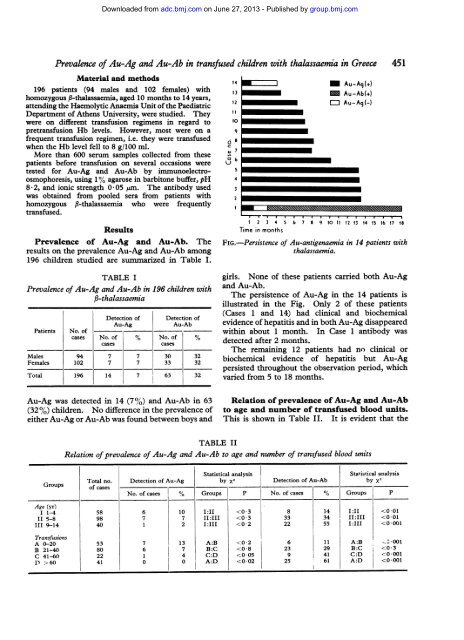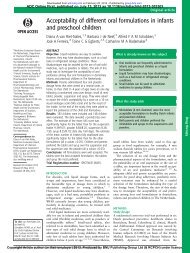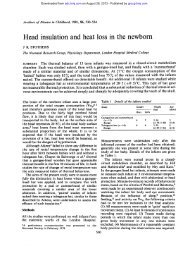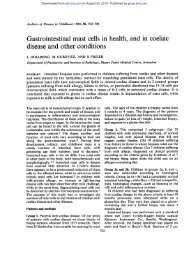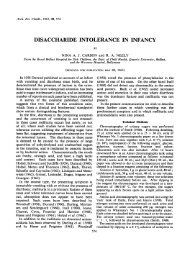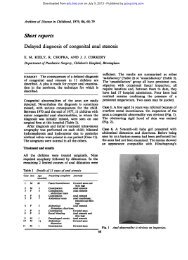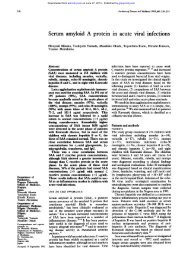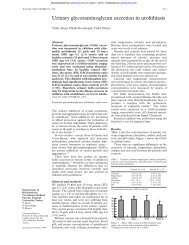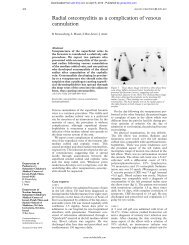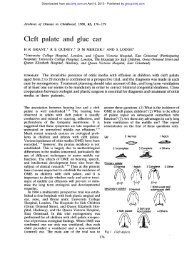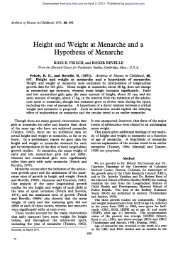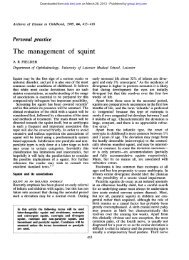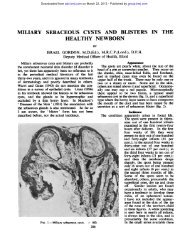Prevalence of Au-Ag and Au-Ab in transfused children with ...
Prevalence of Au-Ag and Au-Ab in transfused children with ...
Prevalence of Au-Ag and Au-Ab in transfused children with ...
You also want an ePaper? Increase the reach of your titles
YUMPU automatically turns print PDFs into web optimized ePapers that Google loves.
Downloaded from<br />
adc.bmj.com on June 27, 2013 - Published by group.bmj.com<br />
<strong>Prevalence</strong> <strong>of</strong> <strong>Au</strong>-<strong>Ag</strong> <strong>and</strong> <strong>Au</strong>-<strong>Ab</strong> <strong>in</strong> <strong>transfused</strong> <strong>children</strong> <strong>with</strong> thalassaemia <strong>in</strong> Greece<br />
Material <strong>and</strong> methods<br />
196 patients (94 males <strong>and</strong> 102 females) <strong>with</strong><br />
homozygous ,-thalassaemia, aged 10 months to 14 years,<br />
attend<strong>in</strong>g the Haemolytic Anaemia Unit <strong>of</strong> the Paediatric<br />
Department <strong>of</strong> Athens University, were studied. They<br />
were on different transfusion regimens <strong>in</strong> regard to<br />
pretransfusion Hb levels. However, most were on a<br />
frequent transfusion regimen, i.e. they were <strong>transfused</strong><br />
when the Hb level fell to 8 g/100 ml.<br />
More than 600 serum samples collected from these<br />
patients before transfusion on several occasions were<br />
tested for <strong>Au</strong>-<strong>Ag</strong> <strong>and</strong> <strong>Au</strong>-<strong>Ab</strong> by immunoelectroosmophoresis,<br />
us<strong>in</strong>g 1% agarose <strong>in</strong> barbitone buffer, pH<br />
8-2, <strong>and</strong> ionic strength 0 05 ,um. The antibody used<br />
was obta<strong>in</strong>ed from pooled sera from patients <strong>with</strong><br />
homozygous P-thalassaemia who were frequently<br />
<strong>transfused</strong>.<br />
Results<br />
<strong>Prevalence</strong> <strong>of</strong> <strong>Au</strong>-<strong>Ag</strong> <strong>and</strong> <strong>Au</strong>-<strong>Ab</strong>. The<br />
results on the prevalence <strong>Au</strong>-<strong>Ag</strong> <strong>and</strong> <strong>Au</strong>-<strong>Ab</strong> among<br />
196 <strong>children</strong> studied are summarized <strong>in</strong> Table I.<br />
TABLE I<br />
<strong>Prevalence</strong> <strong>of</strong> <strong>Au</strong>-<strong>Ag</strong> <strong>and</strong> <strong>Au</strong>-<strong>Ab</strong> <strong>in</strong> 196 <strong>children</strong> <strong>with</strong><br />
,B-thalassaemia<br />
Detection <strong>of</strong> Detection <strong>of</strong><br />
<strong>Au</strong>-<strong>Ag</strong> <strong>Au</strong>-<strong>Ab</strong><br />
Patients No. <strong>of</strong><br />
cases No. <strong>of</strong> % No. <strong>of</strong> %<br />
cases cases<br />
Males 94 7 7 30 32<br />
Females 102 7 7 33 32<br />
Total 196 14 7 63 32<br />
<strong>Au</strong>-<strong>Ag</strong> was detected <strong>in</strong> 14 (7%) <strong>and</strong> <strong>Au</strong>-<strong>Ab</strong> <strong>in</strong> 63<br />
(32%) <strong>children</strong>. No difference <strong>in</strong> the prevalence <strong>of</strong><br />
either <strong>Au</strong>-<strong>Ag</strong> or <strong>Au</strong>-<strong>Ab</strong> was found between boys <strong>and</strong><br />
14 M <strong>Au</strong>-<strong>Ag</strong>(+)<br />
13 M <strong>Au</strong>-<strong>Ab</strong>(+)<br />
12 ED <strong>Au</strong>-<strong>Ag</strong>(-)<br />
II<br />
9<br />
o8<br />
,,7<br />
06<br />
U6<br />
2<br />
1 2 3 4 S 6 7 8 9 I1 12 13 14 15 16 17 18<br />
Time <strong>in</strong> months<br />
FIG.-Persistence <strong>of</strong> <strong>Au</strong>-antigenaemia <strong>in</strong> 14 patients <strong>with</strong><br />
thalassaemia.<br />
girls. None <strong>of</strong> these patients carried both <strong>Au</strong>-<strong>Ag</strong><br />
<strong>and</strong> <strong>Au</strong>-<strong>Ab</strong>.<br />
The persistence <strong>of</strong> <strong>Au</strong>-<strong>Ag</strong> <strong>in</strong> the 14 patients is<br />
illustrated <strong>in</strong> the Fig. Only 2 <strong>of</strong> these patients<br />
(Cases 1 <strong>and</strong> 14) had cl<strong>in</strong>ical <strong>and</strong> biochemical<br />
evidence <strong>of</strong> hepatitis <strong>and</strong> <strong>in</strong> both <strong>Au</strong>-<strong>Ag</strong> disappeared<br />
<strong>with</strong><strong>in</strong> about 1 month. In Case 1 antibody was<br />
detected after 2 months.<br />
The rema<strong>in</strong><strong>in</strong>g 12 patients had no cl<strong>in</strong>ical or<br />
biochemical evidence <strong>of</strong> hepatitis but <strong>Au</strong>-<strong>Ag</strong><br />
persisted throughout the observation period, which<br />
varied from 5 to 18 months.<br />
Relation <strong>of</strong> prevalence <strong>of</strong> <strong>Au</strong>-<strong>Ag</strong> <strong>and</strong> <strong>Au</strong>-<strong>Ab</strong><br />
to age <strong>and</strong> number <strong>of</strong> <strong>transfused</strong> blood units.<br />
This is shown <strong>in</strong> Table II. It is evident that the<br />
TABLE II<br />
Relation <strong>of</strong> prevalence <strong>of</strong> <strong>Au</strong>-<strong>Ag</strong> <strong>and</strong> <strong>Au</strong>-<strong>Ab</strong> to age <strong>and</strong> number <strong>of</strong> <strong>transfused</strong> blood units<br />
Statistical analysis Statistical analysis<br />
Total no. Detection <strong>of</strong> <strong>Au</strong>-<strong>Ag</strong> by X2 Detection <strong>of</strong> <strong>Au</strong>-<strong>Ab</strong> by X2<br />
Groups <strong>of</strong> cases<br />
No. <strong>of</strong> cases 0% Groups P No. <strong>of</strong> cases % Groups p<br />
<strong>Ag</strong>e (yr)<br />
I 1-4 58 6 10 IJ:I


